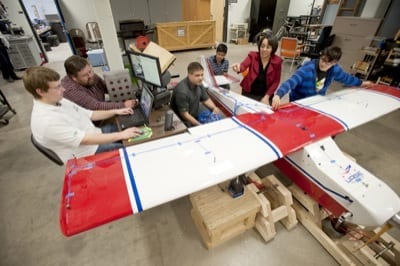By JUAN MIGUEL PEDRAZA, Office of University Relations, University of North Dakota
It looks easy to fly unmanned aircraft: Launch, fly, land. But there’s lots more to keeping an Unmanned Aircraft System (UAS) safely aloft than toggling controls from the ground.
“Among the major technical challenges facing the UAS industry is the sense-and-avoid system aboard the aircraft,” said Naima Kaabouch, associate professor of electrical engineering at the University of North Dakota College of Engineering and Mines and an expert in sense-and-avoid electronics and software.
Sense-and-avoid technology — essentially the intelligent eyes and ears of a UAS — is still a long way from providing the level of observational awareness that a pilot brings to cockpit.
“We’re working on much more sophisticated sense-and-avoid systems that accurately deal with all kinds of possible airborne traffic, including birds, balloons, small aircraft, and parachutists,” Kaabouch said.
“That’s especially important as we move toward aircraft that will one day be equipped with ADS-B or Automatic Dependent Surveillance-Broadcast,” said Mark Askelson, a UND atmospheric scientist who’s a nationally known sense-and-avoid systems and ADS-B researcher. “The ADS-B system, together with more reliable and accurate sense-and-avoid technology, will be vital to future UAS operations.”

ADS-B, Askelson explains, is a tracking technology that will be an integral part of the Next Generation Air Transportation System (NextGen). The federal government will require, as of 2020, that many aircraft — including UAS — operating in U.S. airspace be equipped with some form of ADS-B.
“ADS-B is essentially a transponder aboard a piloted or unmanned aircraft that says ‘I’m here, I’m here,’” Askelson said. As an integral part of a total sense-and-avoid system, he said, ADS-B is about telling other aircraft that you’re out there and lets them know what your path is to avoid potential conflicts.
Kaabouch points out that a special concern of UAS operators are the so-called “non-cooperative” systems, or other aircraft or objects that are not equipped with sensing equipment and don’t send out signals about their position.
“A flock of birds isn’t going to tell you where it is and where it’s going,” Kaabouch said.
William Semke, an associate professor of mechanical engineering at UND and one of the school’s key UAS researchers, says sense-and-avoid technology is really about safety.
“You have to be able to operate the UAS safely when it flies in the national airspace,” said Semke. “We’re working on the instruments and sensors needed to replace the human in the aircraft who would see or ‘sense’— and avoid — moving objects, such as a small airplane or anything up there that isn’t equipped with the technology to notify other aircraft of its presence.”
“We’re not worried in this context about mountains, tall buildings or other terrain features because the UAS today can be equipped with digital terrain maps and would ‘know’ to fly around such obstacles,” he said. “Our technical concern is with all the other objects in the sky that show up unplanned, such as a flock of geese.”
There’s still plenty of work ahead in various UAS technologies, including sense and avoid.
Institutions across the country such as UND are focusing a lot of research energy on UAS, assembling large teams of engineers, scientists and technologists — including both undergraduate and graduate students — from several disciplines.
Recognized leaders in the field, UND’s UAS research teams include folks from unexpected departments, such as nursing and psychology, who are looking at a variety of things, including the human factors involved in remotely piloting UAS.
“UAS has leaped to the forefront of aviation research,” said Bruce Smith, dean of UND Aerospace. “This provides a completely different track from what we’ve already got going on in aerospace sciences.”
“On the engineering side, you’ve got payloads, sensors, composites, and aircraft design,” Smith explained. “On the basic research side, you’re looking at the big problem of sense-and-avoid and the theoretical problems involved in tasking these aircraft, such as optimal mission design and control.”
Part of the sense-and-avoid research at UND involves the Unmanned Aircraft Systems Engineering (UASE) Laboratory, which conducts multiple flight tests of an airborne sense-and-avoid (ABSAA) system comprising an ADS-B transceiver, an Advanced RISC Machine (ARM)-based embedded flight computer, and a Cloud Cap Technology Piccolo II autopilot.
“Refinement of the system’s functionalities has led to its miniaturization while maximizing the use of commercial-off-the-shelf components,” Semke said.
In September, UND will co-host a demonstration day with the MITRE Corporation, NASA Langley, North Dakota State University, and the North Dakota National Guard (NDNG). Together, they’re researching the viability of a Cooperative Automatic Sense and Avoid (CASA) capability for unmanned aircraft.
Flight tests of CASA are being conducted in eastern North Dakota in September. These tests use NASA Langley’s surrogate UAS, which can operate as a manned or unmanned aircraft with the flip of a switch. The eastern North Dakota testing location leverages a multitude of aircraft assets operated by the UND, all of which are already outfitted with ADS-B systems.
The John D. Odegard School Of Aerospace Sciences at the University of North Dakota is a world-renowned center for aerospace learning and research, nationally acclaimed for its achievements in collegiate aviation education; unmanned aviation training, and more.
